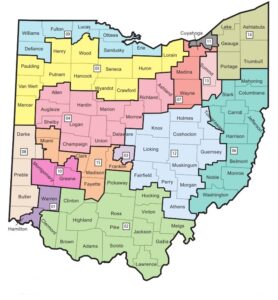Blog Post
Ohio Redistricting Commission Congressional Map
September 7, 2023 Update: The litigation has concluded. This Congressional map will be used for Election 2024. The Ohio Supreme Court dismissed the two lawsuits, leaving the congressional map created on March 2, 2022 in place for the next election.
October 14, 2022: Instead of drawing a new compliant map, a lawsuit Huffman v. Neiman was filed urging the U.S. Supreme Court to step in arguing that because the Elections Clause of the U.S. Constitution authorizes the state legislature to adopt rules for congressional elections, it prohibits the Ohio Supreme Court from enforcing the Ohio Constitution in reviewing the Ohio legislature’s congressional plan. Huffman v. Nieman was sent back to the Ohio Supreme Court on June 20, 2023.
July 19, 2022: a bipartisan majority on the Ohio Supreme Court struck down the March 2, 2022 congressional map – the one used in the May 3 primary. “We hold that the March 2 plan unduly favors the Republican Party and disfavors the Democratic Party in violation of Article XIX, Section 1(C)(3)(a).”
2022 Lawsuits: Two lawsuits were filed against this map:
- The ACLU of Ohio filed a lawsuit on 3/22/22 on behalf of LWVO asking the Court to order the General Assembly, or Commission, to fix the 3/2/2022 map in time for the 2024 election and issue a PI for holding congressional elections for 2024.
- The voting rights groups still claim that Districts 1 and 15 are not constitutionally compliant but cite the electoral calendar as preventing relief in time for 2022.
- The Elias Law Group filed a separate lawsuit on 3/21/22, seeking relief in time for the 2022 elections. The complaint asks the Court to issue a PI for the primary election and court-ordered map chosen. An alternative request for relief asks the Court to order the General Assembly, or Commission, or draw a map in accordance with the Courts 1/14/22 order.
March 2, 2022: Senate President Huffman introduced what would be voted on and passed through the Commission as the Second Congressional Map hours before the Ohio Redistricting Commission hearing. During the hearing, Democratic Amendments to the proposed map were rejected along party lines. The Commission then took a vote and the Second Congressional Map was approved, again along party lines.
